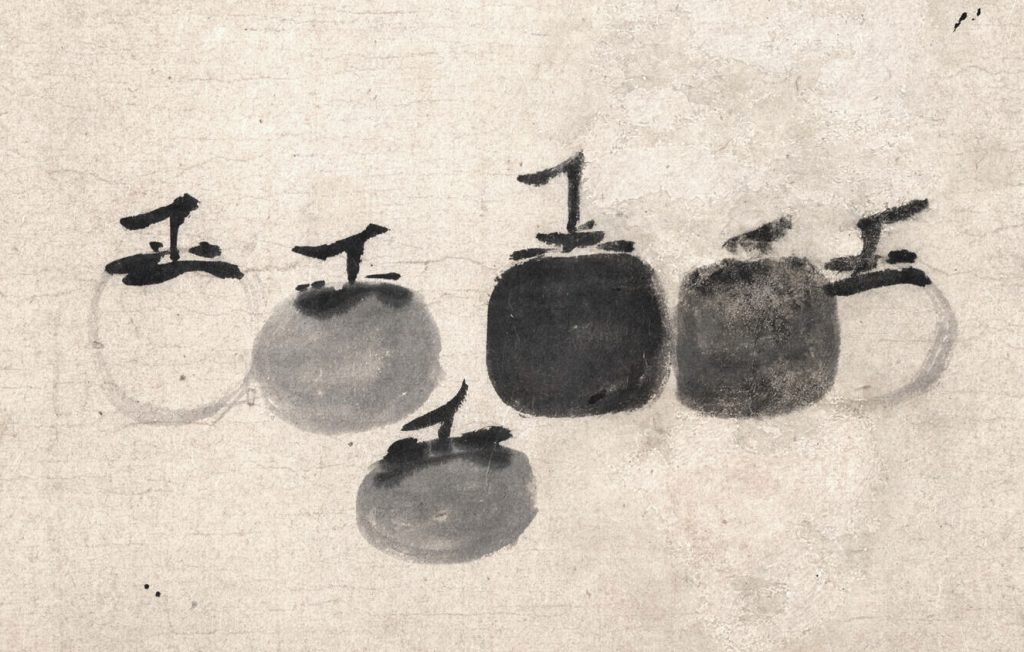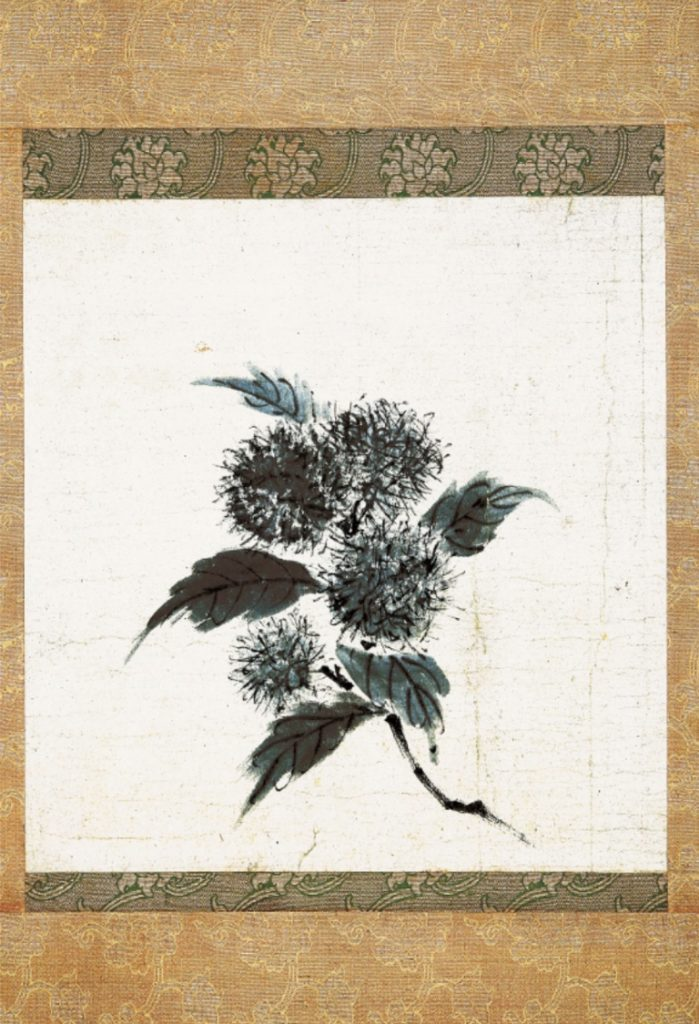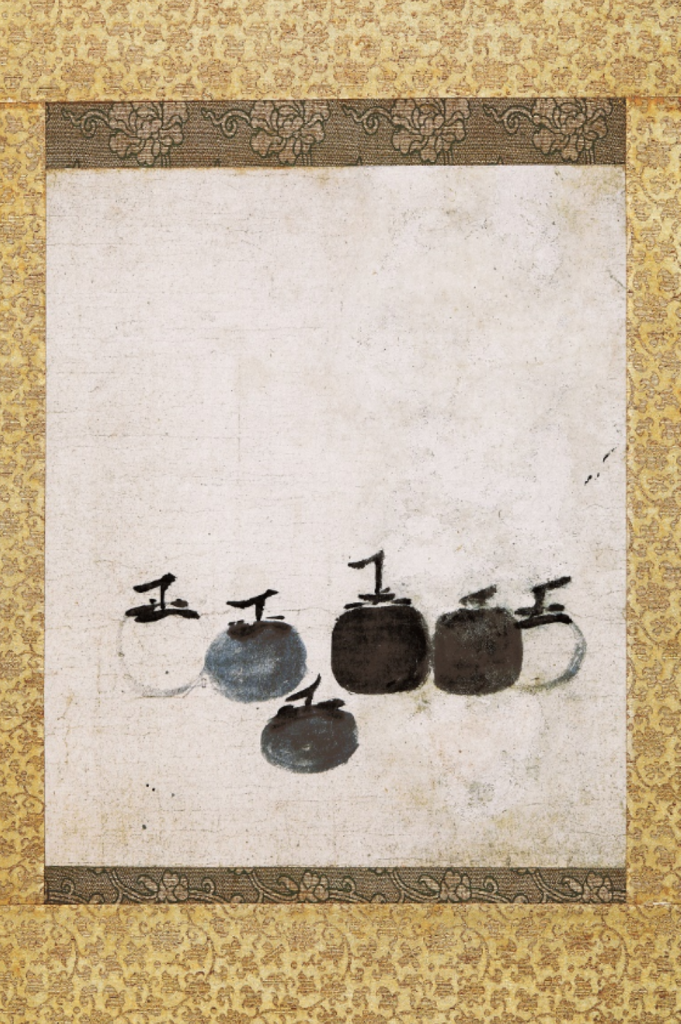The famed ink paintings by Muqi have never left Japan before. Now, they are headed to San Francisco.

Attributed to Muqi, ‘Persimmons’ (13th century), detail.
China; Southern Song Dynasty.
Lent by Daitokuji Ryokoin Temple, Kyoto.
Photo © Kyoto National Museum.
A pair of Japanese national treasures that are considered among the world’s most important Zen Buddhist masterpieces come to San Francisco, where they will be part of a once-in-a-lifetime exhibition at the Asian Art Museum.
The two ink paintings, Persimmons (popularly known as Six Persimmons) and Chestnuts, are attributed to the famous Chinese artist Muqi, a Song Dynasty monk who lived from about 1210 to 1269. The paintings also gained prestige when Japanese government designated them as important cultural property in 1919.
“When I was taking art history courses in school, these paintings were always discussed and in the textbooks,” the museum’s associate curator of Japanese art, Yuki Morishima, said, admitting she “was kind of starstruck” to learn they would be coming to the Bay Area.
“The use of dark and light tones within the brushwork is really something to marvel at. It seems very simple, but actually they’re quite complex and would be difficult to achieve by someone who wasn’t quite skillful in their handling of the brush,” Laura Allen, the museum’s senior curator of Japanese art, added. “It’s interesting to look at the composition and the use of negative space, and to see how carefully placed each of the persimmons is and how the chestnuts are arranged.”

Attributed to Muqi, ‘Chestnuts’ (13th century), detail.
China, Southern Song Dynasty.
Lent by Daitokuji Ryokoin Temple, Kyoto.
Photo © Kyoto National Museum
They are on loan from the Daitokuji Ryokoin temple in Kyoto, which has owned them since the early 1600s. The two works haven’t left the country since their arrival at some point in the 1400 or 1500s, and the Zen Buddhist temple is not open to the public, making this a unique opportunity to experience a pair of paintings that have been famous for generations. (Both pieces were seen briefly at the Miho Museum, about an hour outside of Kyoto, in a 2019 exhibition.)
The San Francisco show has been in the works since 2017, when the temple’s abbot, Kobori Geppo, came to the Asian Art Museum while in town for a symposium. By the end of the visit, he had shocked everyone by proposing a historic loan of Muqi’s work. “We were quite surprised by the proposal and very honored,” Morishima said.
The works will be on view for just three weeks each, overlapping for only three days in the center of the run, betwen December 8 and 10. Loaning the works required approval from the Japanese government’s Bureau of Cultural Affairs, with all sorts of restrictions designed to ensure the paintings’ safety, including carefully monitoring the lighting and humidity at the galleries.

Attributed to Muqi, ‘Persimmons’ (13th century), detail.
China; Southern Song Dynasty.
Lent by Daitokuji Ryokoin Temple, Kyoto.
Photo © Kyoto National Museum.
Though the paintings have become famous in the West as the best-known example of Zen Buddhist art, the two hand scrolls originally would not have been seen as particularly spiritual. Instead, they would have served a decorative function, displayed during tea ceremonies in an alcove called the tokonoma, intended for artworks.
What has been special about the works from the beginning was the artist, who remains incredibly renowned in Japan—even more so than in his native China.
“Muqi is a big name in Japan and has been for centuries. He was popular in China, but it was a short-lived popularity,” Morishima said. “The Japanese tend to like more atmospheric brushstrokes while the Chinese historically prefer more precise brushstrokes and naturalism.”
The artist’s outsized influence in Japan made him a likely starting point when Western scholars began studying the field, and helped solidify the now-outsize reputation of Persimmons and Chestnuts.
“Early in the early 20th century, and certainly by the 1920s, there was a kind of fascination with the idea of Zen Buddhism in the West,” Allen said. “These paintings became part of the literature of quote-unquote ‘Zen art’, and at a certain point attained the status of being iconic works. The idea was that their simplicity and the perceived spontaneity of the paintings was characteristic of Zen and its expression in art.”
“The Heart of Zen” will be on view at the Asian Art Museum, 200 Larkin Street, San Francisco, California, November 17–December 31, 2023. Six Persimmons will be displayed November 17–December 10, 2023, and Chestnuts will be displayed December 8–31, 2023.
Source: artnet







